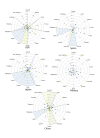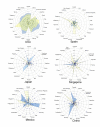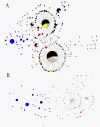What happened after the initial global spread of pandemic human influenza virus A (H1N1)? A population genetics approach
- PMID: 20727188
- PMCID: PMC2936310
- DOI: 10.1186/1743-422X-7-196
What happened after the initial global spread of pandemic human influenza virus A (H1N1)? A population genetics approach
Abstract
Viral population evolution dynamics of influenza A is crucial for surveillance and control. In this paper we analyzed viral genetic features during the recent pandemic caused by the new influenza human virus A H1N1, using a conventional population genetics approach based on 4689 hemagglutinin (HA) and neuraminidase (NA) sequences available in GenBank submitted between March and December of 2009. This analysis showed several relevant aspects: a) a scarce initial genetic variability within the viral isolates from some countries that increased along 2009 when influenza was dispersed around the world; b) a worldwide virus polarized behavior identified when comparing paired countries, low differentiation and high gene flow were found in some pairs and high differentiation and moderate or scarce gene flow in others, independently of their geographical closeness, c) lack of positive selection in HA and NA due to increase of the population size of virus variants, d) HA and NA variants spread in a few months all over the world being identified in the same countries in different months along 2009, and e) containment of viral variants in Mexico at the beginning of the outbreak, probably due to the control measures applied by the government.
Figures







References
-
- Perez-Padilla R, de la Rosa-Zamboni D, Ponce de Leon S, Hernandez M, Quiñones-Falconi F, Bautista E, Ramirez-Venegas A, Rojas-Serrano J, Ormsby CE, Corrales A, Higuera A, Mondragon E, Cordova-Villalobos JA. INER Working Group on Influenza. Pneumonia and respiratory failure from swine-origin influenza A (H1N1) in Mexico. N Engl J Med. 2009;361:680–689. doi: 10.1056/NEJMoa0904252. - DOI - PubMed
-
- WHO influenza update page. http://www.who.int/csr/don/2009_05_04a/en/index.html
Publication types
MeSH terms
Substances
LinkOut - more resources
Full Text Sources
Medical

